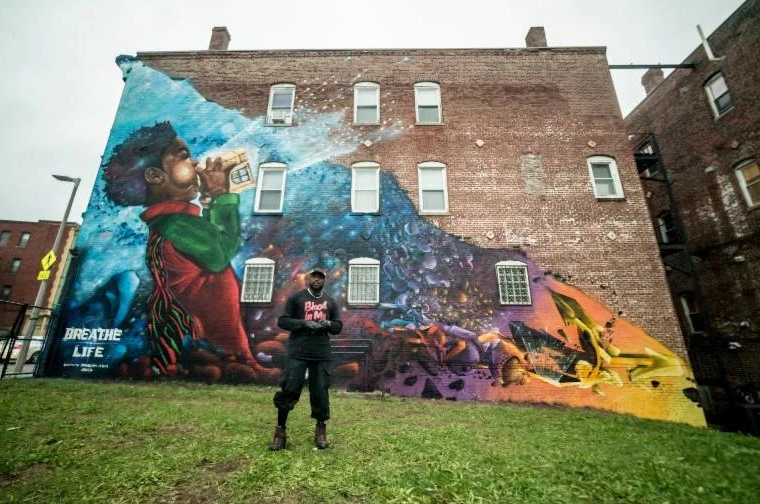JUDY WOODRUFF: As protests and rallies against racism escalate throughout the country, Boston artist Robert ProBlak Gibbs says, rather than put his voice front and center, he will paint the backdrop. In teaming with that city's Museum of Fine Arts, that's exactly what he's doing right now. WGBH's Jared Bowen recently joined Gibbs at the site of his latest mural to discuss the power of positivity in painting. The story is part of our ongoing arts and culture series, Canvas.
JARED BOWEN: For artist Robert Gibbs, the routine is straightforward, rise up and get rolling with music.
ROBERT PROBLAK GIBBS, Artist: So, they're songs that either I'm familiar with from listening to my moms and pops jamming on a Saturday or things that I have grown up with just throughout all my life. Music is definitely a vital component to painting.
JARED BOWEN: The lifelong Bostonian is working on the third mural in his Breathe Life series, epic-sized works bringing fresh air into the city's Dorchester and Roxbury neighborhoods. Begun in 2017, they offer a narrative, first, a little boy with massive might. Two years later, Gibbs painted him as deliriously happy, supporting his equally joyous sister on his shoulders. Now, in his latest piece commissioned by the Museum of Fine Arts, she's floating into the world on her own.
ROBERT PROBLAK GIBBS: She's blowing a series of bubbles. And out of the series of bubbles, there's going to be one of them that's big enough that covers and protects her whole entire body.
JARED BOWEN: What do we see in her hair?
ROBERT PROBLAK GIBBS: You see the universe, the galaxy, so, the universe is always on her mind.
JARED BOWEN: On his mind has been Gibbs' 2-year-old daughter making sure that, as she grows up in Boston in these times, she has something to look up to. It's an uplifting message. And so, instead of trying to, as I would say, feed steak to a baby, I would sneak the pill in the applesauce.
ROBERT PROBLAK GIBBS: And so hopefully it's something that she grows up with and other little kids to see themselves in the murals.
JARED BOWEN: Gibbs also grew up here, venturing into graffiti art as a teenager in the early 1990s.
ROBERT PROBLAK GIBBS: It's just the ability to hack or manipulate the ideas from these little cans.
JARED BOWEN: He stuck mostly to his neighborhood, mostly to buildings where he and fellow artists had permission to paint.
ROBERT PROBLAK GIBBS: And these are areas and buildings that people or the city wasn't even caring about that we were putting the beauty in.
JARED BOWEN: Part of his inspiration came from movies that cracked open his view of the possible.
ROBERT PROBLAK GIBBS: One of the films was Beat Street and then Star Wars. And there was brothers and sisters in there that looked like us. And I was like, yo, what they're doing is speaking for the culture in such a large platform.

JARED BOWEN: Today, Gibbs' own platforms are expansive, too. Of course, there are the towering walls. But there's also Artists For Humanity, the institution he co-founded almost 30 years ago that puts under-resourced teenagers to work as artists. And now the museum commission, which also makes him an artist-in-residence. It's timed to coincide with an upcoming exhibition of legendary street artist Jean-Michel Basquiat. But, more importantly, says the MFA's Makeeba McCreary, the museum is moving past a long history where local artists of color have often been left to the margins.
MAKEEBA MCCREARY, Chief of Learning and Community Engagement, Museum of Fine Arts: He's saying, I'm willing to be your partner in this and to be equals in this relationship. But, really, the gift is to us.
JARED BOWEN: Why is that important to you that, and that it comes in that order, with that emphasis?
MAKEEBA MCCREARY: You know, Black artists, Black artists from Roxbury, from Dorchester, from Mattapan have not traditionally been acknowledged in our collection and in our programming.
JARED BOWEN: The Breathe Life mural's timing is also horribly coincidental, as the killing of George Floyd has once again reminded the nation of the sanctity of breath.
ROBERT PROBLAK GIBBS: In a state where we cannot breathe, I'm asking people to take the time to breathe and look at what's going on. People are walking around with their head down, angry, mad. And when you look at these murals, they're so large in size, it's a minute to take a breath and look up and see what's promising, you know?
JARED BOWEN: Already drawing visitors, the mural is painted on Gibbs' alma mater, Madison Park High School, a sentimental spot, but one that is also easily visible a mile away. And it's no accident that this girl floats over Boston police headquarters.
MAKEEBA MCCREARY: She's owning her place, her rightful place in the city. And you want everybody to see that. But, mostly, you want little brown and Black girls and boys to see that.
JARED BOWEN: They will also see, when Breathe Life is finished, Gibbs' signature, his artist name, ProBlak.
ROBERT PROBLAK GIBBS: It's our name. Pro is for. Blak is our people. And so that signature, or the style, or what people see alone and can connect with me as an artist, it speaks volumes, man. And it feels great, because now, you know, I have got my daughter telling me I'm a superhero, though.
ROBERT PROBLAK GIBBS: So I'm going to just continue to grow on and flow on, man.
JARED BOWEN: For the PBS NewsHour, I'm Jared Bowen in Boston, Massachusetts.













